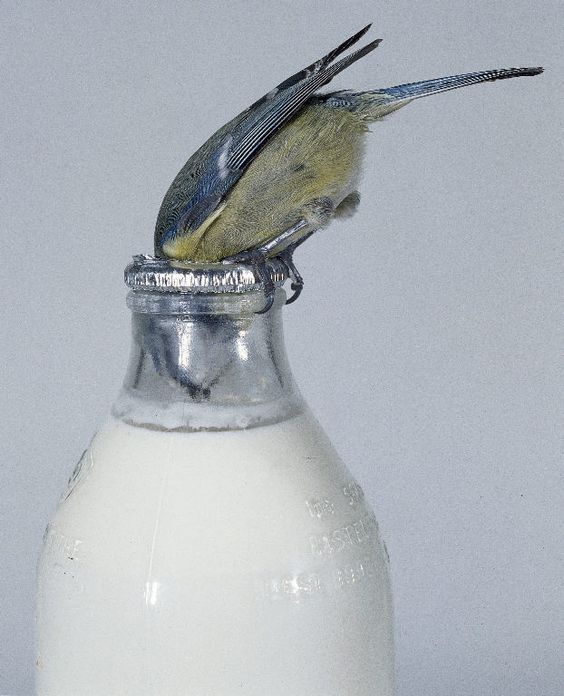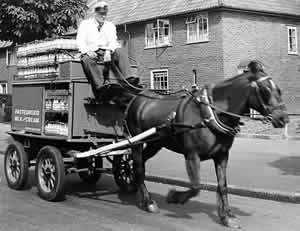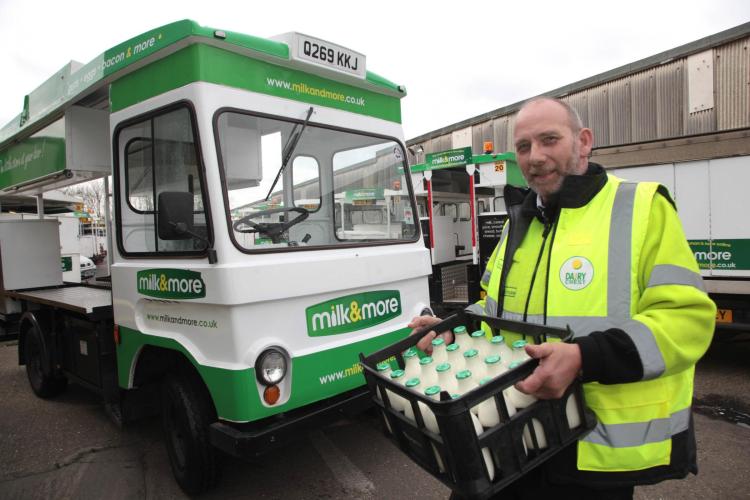If you’re anything like me then if you cast your mind back to around 7am or so then up until the late 1980’s you’d likely be very familiar with the jingle of milk bottles and the heavy clunk as they were placed on doorsteps. There’s almost certainly a couple of foil-topped glass milk bottles there. Maybe more. Some of the tops may have been pecked by birds, although if you left a couple of plastic cups out the milkman probably popped those over the top of the bottles to protect them.

Back then in the UK 94% of milk was put into glass bottles, according to Dairy Crest. By 2012, this was just 4%.
You’d also likely reminisce about the morning whirr of electric floats, the different coloured foil tops that denoted which type of milk was inside and most satisfying, of all the weirdly satisfying way of opening them – a push just powerful enough to dent but not break it.Birds were attracted to peck away at the caps to get to the cream line,” says Paul Luke, editor of Milk Bottle News and the owner of some 12,000-13,000 glass milk bottles.
Birds were attracted to peck away at the caps to get to the cream line and because milk wasn’t processed as much as today, even the semi-skimmed milk would have cream at the top and it would all be a little different than the slightly watered down
Leaving out the empties represents many people’s first understanding of the concept of recycling. But there’s been a slow but lengthy decline with the proliferation of fridges in the 1950s, which allowed milk to be kept longer, meaning the three daily deliveries reduced to one. By the 1990s, the deregulation of the British milk industry and the decision by supermarkets to sell milk – cheaply – in plastic containers changed everything.
I very well remembering protesting to my parents that they were taking part in destroying a tradition and vital community service for the sake of saving some money but I didn’t pay the bills.
I’ve never really liked the plastic containers, I thought milk even tasted better from glass bottles which is kind of fortunate now as I can’t drink so am reduced to drink soya milk from cartons.
These days there are only 5-9,000 milkmen delivering about 5-10% of our daily milk. Plastic containers are cheaper to make and lighter for transport which goes a long way to offset against the issues of recycling them.
Convenience and cost has triumphed. Smaller dairies may continue to provide milk in glass bottles.
Milk used to be advertised in a way that was way cooler than current unhealthy foods and drinks. The 1970s saw adverts in which mysterious creatures called Humphreys attempted to steal milk with long straws. “Watch out, watch out, there’s a Humphrey about,” was the slogan. Muhammad Ali got involved.
The catchphrase “Gotta lotta bottle” followed. It’s hard to imagine a series of more 1980s-style videos – whirlwinds of dazzling neon, innuendo, and the chanted tagline “nice cold, ice cold milk”. This was an era when Linford Christie raced a milk float.
Not to mention the all time classic milk advert with two young boys fighting over milk so that they will be good enough to play football for Liverpool rather than Accrington Stanley.

- First glass milk bottle patented in 1874 in the US
- Gradually transferred to UK but until WW1 milk mainly delivered on horse-drawn “milk pram” – ladled into tin cans from a churn
- At that time, milk was delivered three times a day – “pudding round” later dropped due to WW1 constraints
- By 1920s and 1930s glass-bottled milk is the norm, but bottles had cardboard slips at the top, which children used to play “pogs”
- 1935 – slender-neck bottle introduced, giving the illusion of more cream and supposedly favoured by housewives
- Aluminium foil tops eventually replaces cardboard for hygiene concerns – but WW2 shortages mean experimentation with zinc, tin and lead-based alternatives
- Estimated 30 million lost glass bottles a year during WW2 – some return to tin can delivery using ladles
- 1980 – modern version of bottle introduced. Shorter and wider, initially it was nicknamed “dumpy”
Milkmen regularly had a career of 30 to 40 years and often became family friends, says Phelps. The milkman would go around and collect the money and would then be invited in for a cup of tea. Like postmen, they would often be a vital source of contact for the elderly and infirm as well as helping out in vital unpaid and additional services such as deterring night crime and even looking after pets when people are on holiday.
In the old days, Milkmen would be up at 4 or 5am and be finished soon after breakfast but now milk is cheaper than water and the supermarkets pricing strategy of selling milk at or below cost isn’t just ruining farmers but putting milkmen out of business as their purchase price becomes as high as supermarket prices to the consumer.
Today milkmen areas can have a round that is 100 miles whereas as urban milkmen can start their day around midnight and be finish at midday as they stock up on some of the 500 items that many sell to supplement their milk.
So why am I writing about milk today? Well yesterday the local milkman knocked on every door in my street and several dozen people have signed up, perhaps all fed up with the over-commercialisation of the supermarkets and their treatment of food producers. Or perhaps they don’t mind paying a little more to get personal and high-quality service.

I’ve opted for a delivery by a milkman as I like tradition and helping small businesses, I already shun supermarkets so this is just a nice little extra that I am happy to pay a little extra for that. Also as I can only drink Soya milk, the local shops often run out and only have other non-dairy milk such as rice, coconut and almond which I have tried but actively dislike. Now I no longer have to always keep an eye on my milk or walk around the streets for an hour just to get some milk. Nor do I have to carry 5 or 6 litres back, it will all come to my front door by 7.30am.
These days I don’t have to leave a note out if I want to change my order or go away, I get my own login account and can go online and change my usual order until 9pm at night and even pay online too.
Well done Stephen. The small businesses are the real heroes of our streets.
LikeLiked by 1 person
Yes they are. When I get the 6am bus, I look around and see the real people who work hard and keep things going for everyone else. At least half are small business owners and the rest are the hardworking public sector people.
LikeLike
I miss the cream on top of the milk. Loved putting it on my porridge in the morning. Oh those were the days. Nice to know he’s trying to make a come back. A very interesting read.
LikeLiked by 1 person
It was only while researching this that I realised that milk today has a slightly watery consistency. None of the cream of times gone by.
LikeLike
We’ve never seen milkmen do their run. Might be interesting to post a video!
LikeLiked by 1 person
I will try that one day when I get to know him a little.
LikeLiked by 1 person
We no longer have milk delivery here but I’m old enough to remember the last horse drawn milk wagon in my home town. The horse (Bobbie) knew the route so well she chugged along by herself while the milkman (who was called Milkman) went back and forth from the wagon. Glad to see you’re sticking with tradition.
LikeLiked by 1 person
What a wonderful memory to have. It is a shame you no longer have a milk delivery. Hopefully by embracing the Internet, the remaining milkrounds will survive. In a way, what could be better than having someone deliver fresh food and drink to your house early every morning. Total convenience!
LikeLiked by 1 person
Curious: what was the name of the National union for milkmen?
LikeLike
I’ve got a lot of memories of milkmen, and we still have one, but he only comes three times a week, often before midnight, so we had never seen him until we got fed up with him and left a note to cancel completely, which brought him knocking on our door. I’ve blogged the story at: http://www.taskerdunham.com/2017/09/doorstep-deliveries.html
LikeLike
I remember as a child in the late 1940s or early 1950s being allowed to hold the reins of the horse drawn milk float in West Wickham. Also being sent out with bucket and shovel to claim the manure for our garden!!
When was the last horse drawn delivery by Unigate in West Wickham, I wonder?
LikeLike
Great article, really interesting. We’ve just signed up to Milk and More and really happy with their new Oato oat milk in a glass reusable bottle.
LikeLiked by 1 person
I used to be with Milk and More until I moved 1 year ago today. They didn’t have that product back then but I will see if I can get on another round again. It’s so much better than the supermarkets. I hope the glass bottles make that satisfying noise when they are rested on the ground 🙂
LikeLike
Something I never see mentioned in these nostalgia pieces about milkmen is who REALLY delivered the milk to the doorsteps. In the early 90’s, aged 12-15 in Scotland I was part of a team of boys who would get be up at 3 am for a 4am start time (or 2am for 3am start on Saturdays – double delivery) , running the streets and flights of stairs in multi-stores flats carrying one or two crates (20 bottles p/crate) in all weather, while the milkman casually drove around in his float. This was 6 days a week (plus two evenings driving round with the milkman collecting money) and all for the princely sum for £20 p/ week.
LikeLiked by 1 person
Wow, I always wanted to nab a milk round job as they were a step up from a paperboy but the diary yard depot for the floats was 7 or 7 miles away. I bet you did a lot of the hard work while the milkman sat in his cabin with the radio on!
LikeLike
Hi, Stephen. Thanks for the repl…and please forgive my typing errors (I was on my phone).
Yeah, the general consensus in our town was milkboys were a cut above the paperboys LOL. Bear in mind we were working with full-grown adult men with families to feed and bills to pay, dependent on us running non-stop for 4 hours every morning no matter what the weather. I don’t recall a delivery day being cancelled EVER. 4am, deep in mid-winter with winds coming off the Irish Sea
cutting you in half. We used to start out with the old-style hot water bottles strapped to out fronts and backs, underneath two heavy work jackets, but within 30 minutes we’d be stripped down to t-shirts drenched in sweat.
And yes, the milkman would kick back driving slowly down the street listening to the radio, occasionally sauntering up the path at carefully-selected houses to drop off a bottle of orange juice now and then.
That being said, come Christmastime the customers knew who was actually delivering the milk and would give us some hefty tips. I recall one of our drivers being quite miffed on his first year that us boys got around 300 quid apiece and he got a 6-pack of lager and a pair of denim jeans LOL
LikeLiked by 1 person
I was a milk boy for Thwaites horse drawn milk cart in Liverpool in the 60’s. Great job, loved how the horse just walked on slowly and us boys kept up with it. After they finished the horse drawn rounds for good we used to deliver it from a back of a small grey open wagon with a drop down tail at the back. Then they must have sold up but i still worked for John Thwaite but he was now working for Hansens dairy in Upper Parliament Street. I used to get up at stupid o’clock each morning, walk to the depot get the electric float and sometimes I would top it up with crates and then drive it to Johns flat and knock him out of bed!! I had my own bag for when we were out collecting for milk money. I remember one the the TV news channels filming us on the last day with the horse, probably ITN but not sure. Great memories of those days!!
LikeLiked by 1 person